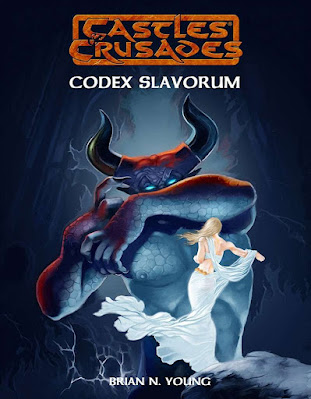Castles & Crusades Codex Slavorum
For this review, I am considering the PDF and hardcover book. The book is 94 pages. Color covers, black & white art. Written once again by Brian Young. He doesn't say it in the books, but it is Brian N. Young, Ph.D. He worked hard and earned his degree and it should be recognized.
Chapter 1: In Bygone Years
Like the previous volumes, this chapter covers both the real-world history and the myths of the area. The area in question surrounds the Black Sea in Eastern Europe.
We get some pre-history, but the people we call the Slavs will get their start in this volume with Byzantine Empire. The time period here is parallel to both the Germanica and Nodica books.
The myths of the area are all new to me and while Young (the author) does a good job in his summary, it leaves me wanting to seek out more. I suppose that is the point right?
Chapter 2: The Whole World & That Which is Beyond
This goes into detail about the lands of the Slavs and these myths. I have now gone through five of these Codecies and I am thinking that a Castles & Crusades game in Mythic Earth is a great idea. There is a nice map of the Slavic Kingdoms.
The second half of this covers the mythic lands of the Slavs; the three worlds. Like the Norse, these are placed on the World Tree, the Drugi Svet. Young even mentions that combination is possible but does not (correctly) tell you how since it would depend on YOUR world. The three worlds are Parv (or Iriy or Vyrjy), the realms of light, the lands of summer, and the home of the Gods. Lav (or Yav) is the middle realm of men, and Nav the Underworld. Here Czernobog becomes the Devil-like figure. Indeed it might be hard to tease out what is Czernobog and what is "Lucifer" in modern depictions of "the Devil." Svarog is our creator deity of light.
In a case of supporting my "One Man's God" series, there is Peklo, the Abyss, which is the home of various demons. Demons it seems very much in the AD&D mindset.
There are more lands and frankly, the more I read the more I want to use all of this in a game.
Chapter 3: Did Dwell Many Peoples
Our monster chapter. Monsters are "false creations" (my words, not so much Young's) of Czernobog. And there are some GREAT monsters here. Nearly 50 monsters here. Some are familiar to any D&D players, but many are new to *D&D games or at least in this form.
There are a couple new "races" that characters can be. The Zmajevit, or the "Dragon born" are humans with dragon blood in them. The Zduhac, or the Elemenatal ones, are elemental influenced humans.
There is also a new class here, the Vampirdzhija or the Vampire Hunter. This is a Wisdom-based class. Essentially the Vampire Slayer of the Slavic cultures.
Chapter 4: Filled with Great Magic
Another favorite section this one covers magic and new magic-using classes. The Kolduny is a new type of wizard that is Wisdom-based. The Molfar is the Slavic shaman, also Wisdom-based.
There are a few names mentioned for other types of spell casters. These are just names for other types, but do not have their own class per se.
Chapter 5: Of Mighty Gods and Spirits
This chapter takes the myths and reshapes them into something that can be used with Castles & Crusades but of course any other game. And there are a lot of gods here! Some are familiar to me, but most are brand new.
There is some text on the pagan religions of the Slavs and their practices.
Chapter 6: Battle Strong and Heroic
This is typically the "fighters" chapter. This one covers the weapons used by the Slavs and mentions of the heroes and groups of heroes of their tales.
Chapter 7: Castle Keeper Info
This is the GM's or Castle Keeper's information on running a game using these rules. Like the others in this series, this includes names and the various laws of the lands.
More so than the other books this one left me wanting more. This is a good thing and not a fault of the book. It is due to my own unfamiliarity with these myths and stories. It would work well with the Germanic and Nordic books for greater world-building. Now I want books like this for all the big myths of the world.
Maybe one for Spain and Al-Andalus should be next? What do you think Dr. Young?



3 comments:
Maybe review the Egyptian Codex next to gain some contrast to the other volumes
Yes! I have that one planed for Friday.
Looking forward to seeing it on Fridaty pal!
Post a Comment